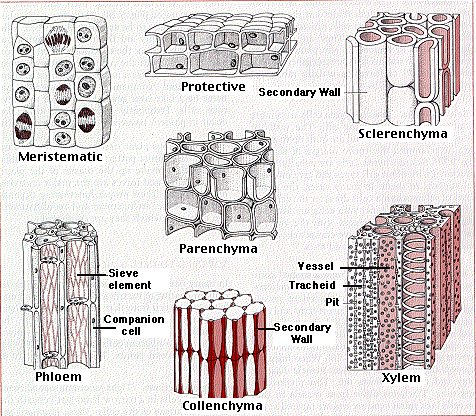| Index to this page |
A mature vascular plant (any plant other than mosses and liverworts), contains several types of differentiated cells. These are grouped together in tissues. Some tissues contain only one type of cell. Some consist of several.
The main function of meristematic tissue is mitosis. The cells are small, thin-walled, with no central vacuole and no specialized features.
Meristematic tissue is located in
The cells produced in the meristems soon become differentiated into one or another of several types.

The cells of parenchyma are large, thin-walled, and usually have a large central vacuole. They are often partially separated from each other and are usually stuffed with plastids.
In areas not exposed to light, colorless plastids predominate and food storage is the main function. The cells of the white potato are parenchyma cells. [View]
Where light is present, e.g., in leaves, chloroplasts predominate and photosynthesis is the main function. [View]
The walls of these cells are very thick and built up in a uniform layer around the entire margin of the cell. Often, the cell dies after its cell wall is fully formed. Sclerenchyma cells are usually found associated with other cells types and give them mechanical support.
Sclerenchyma is found in stems and also in leaf veins. [View] Sclerenchyma also makes up the hard outer covering of seeds and nuts.Xylem conducts water and dissolved minerals from the roots to all the other parts of the plant.
| Link to discussion of water and mineral transport in the xylem. |
In angiosperms, most of the water travels in the xylem vessels. These are thick-walled tubes that can extend vertically through several feet of xylem tissue. Their diameter may be as large as 0.7 mm. Their walls are thickened with secondary deposits of cellulose and are usually further strengthened by impregnation with lignin. The secondary walls of the xylem vessels are deposited in spirals and rings and are usually perforated by pits. [View]
Xylem vessels arise from individual cylindrical cells oriented end to end. At maturity the end walls of these cells dissolve away, and the cytoplasmic contents die. The result is the xylem vessel, a continuous nonliving duct.
Xylem also contains tracheids. These are individual cells tapered at each end so the tapered end of one cell overlaps that of the adjacent cell. Like xylem vessels, they have thick, lignified walls and, at maturity, no cytoplasm. Their walls are perforated so that water can flow from one tracheid to the next. The xylem of ferns and conifers contains only tracheids.
In woody plants, the older xylem ceases to participate in water transport and simply serves to give strength to the trunk. Wood is xylem. When counting the annual rings of a tree, one is counting rings of xylem [View].
Sieve elements are so-named because their end walls are perforated. This allows cytoplasmic connections between vertically-stacked cells. The result is a sieve tube that conducts the products of photosynthesis — sugars and amino acids — from the place where they are manufactured (a "source"), e.g., leaves, to the places ("sinks") where they are consumed or stored; such as
Sieve elements have no nucleus and only a sparse collection of other organelles. They depend on the adjacent companion cells for many functions.
Companion cells move sugars, amino acids and a variety of macromolecules into and out of the sieve elements. In "source" tissue, such as a leaf, the companion cells use transmembrane proteins to take up — by active transport — sugars and other organic molecules from the cells manufacturing them. Water follows by osmosis. These materials then move into adjacent sieve elements through plasmodesmata. The pressure created by osmosis drives the flow of materials through the sieve tubes.In "sink" tissue, the sugars and other organic molecules leave the sieve elements through plasmodesmata connecting the sieve elements to their companion cells and then pass on to the cells of their destination. Again, water follows by osmosis where it may
| Link to more details on transport in the phloem. |
| Welcome&Next Search |